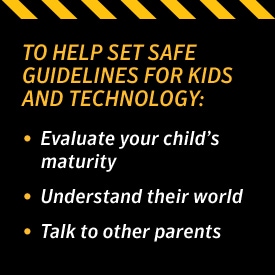When are kids ready for technology?
Many parents struggle to evaluate how old their children should be to safely surf the Internet, handle instant messaging, use smartphones and set up social networking sites. Learn the steps to introduce technology to your child.

Today’s tweens and teens stay connected through text messaging rather than phone calls, with many wanting their own social media accounts. Facebook, Twitter, Instagram, Snapchat...these and other social media sites provide plenty of entertainment for kids. However, parents may worry about issues such as online predators and cyberbullying.

A security suite that helps protect your devices.
Free security software just doesn’t have the resources to keep up with new threats as they emerge. That’s why you need a multi-layered defense to security. Meet Norton Security Premium — protection for up to 10 of your devices.
Subsequently, many parents struggle to evaluate how old their children should be to safely surf the Internet, handle instant messaging, use smartphones and set up social networking sites. Today’s kids are inundated with technology.
Here are some steps to help set safe guidelines for kids and technology:
1. Evaluate your child’s maturity.
Will your child be able to handle situations that might arise with the use of a smartphone or Facebook? How would they handle contact from a stranger? Peer bullying?
2. Understand their world.
If your child tells you all his or her friends have a smartphone, don’t dismiss the social pressure he or she is feeling. For many kids, the fact that all their friends are doing something is very, very important. In an era where tweens and teens don’t hang out in parks or malls as much because of time constraints and safety concerns, technology offers a social connection. If your child is lagging behind their peers in use of technology, it could result in social isolation.
3.Talk to other parents.
Try working as a group to establish guidelines about obtaining and using technology. Make sure at least one parent in your circle is an expert in the latest technological applications. Reading technology and security based blogs always helps.
4. Age appropriateness

Educating yourself and then discussing the use of technology with your child is critical. Here are a few pointers that will help parents help their children navigate the digital landscape.
The Internet
Children 12 and under shouldn’t access the Internet without a parent’s permission. And you’ll want to use parental control software to limit your child’s access to inappropriate material. Keep the computer in a public space in your home. It’s reasonable to allow high school-age kids computer access in their rooms, but you’ll want to establish clear limits related to pornography, graphic websites and other off-limits material.
Social networking
Social media sites such as Facebook have age limits. However, that doesn’t stop many kids under 14 from using social networks. Young kids can be exposed to inappropriate material or harassing behaviour, but frequently lack maturity or sophistication to handle such material/behavior before year 10.
Texting or instant messaging
Children over 12 years old who’ve demonstrated some maturity should be able to handle texting and instant messaging. Cyberbullying is a hard no. It is a punishable offense. So stay aware. Kids should know the signs of cyberbullying and report it immediately to an adult they trust.
Smartphones
When it comes to handling the responsibility of a smartphone, it’s important to spell out how you want your child to use the phone. Make sure you’re aware of the phone’s many functions and how your child might use them. Kids get into trouble taking indiscreet photos of peers with mobile phone cameras. Some schools ban phones because of cheating. And GPS features can pose problems if they allow, for instance, a boyfriend or girlfriend to track your child at all times.
The key to understanding the right age for a child to use technology finally rests with the maturity of the child. That’s an assessment that can only be made by constantly talking to children and observing their behaviour. Setting a good example is as important as setting good boundaries, too.
Using technology as one of the solutions
Norton Security Premium comes with parental controls that make it easy for parents to set time limits and keep inappropriate content out of their child’s device. With a little help from technology, parents can observe their child’s online behaviour and enforce rules. This way children can explore the Internet freely and safely.
Editorial note: Our articles provide educational information for you. Our offerings may not cover or protect against every type of crime, fraud, or threat we write about. Our goal is to increase awareness about Cyber Safety. Please review complete Terms during enrollment or setup. Remember that no one can prevent all identity theft or cybercrime, and that LifeLock does not monitor all transactions at all businesses. The Norton and LifeLock brands are part of Gen Digital Inc.




Want more?
Follow us for all the latest news, tips and updates.